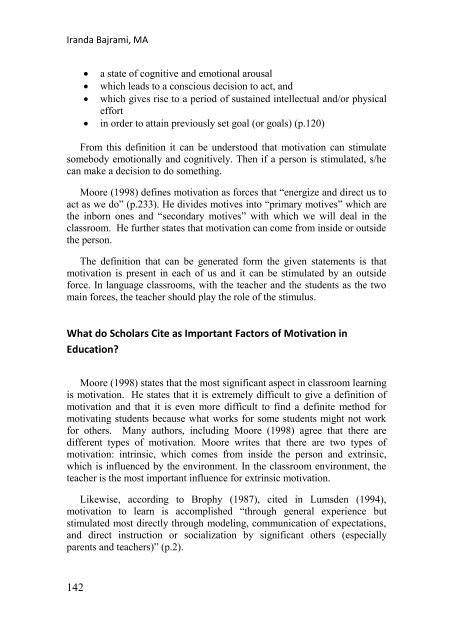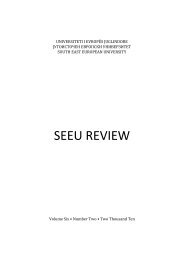SEEU Review vol. 5 Nr. 2 (pdf) - South East European University
SEEU Review vol. 5 Nr. 2 (pdf) - South East European University
SEEU Review vol. 5 Nr. 2 (pdf) - South East European University
Create successful ePaper yourself
Turn your PDF publications into a flip-book with our unique Google optimized e-Paper software.
Iranda Bajrami, MA<br />
<br />
<br />
<br />
<br />
a state of cognitive and emotional arousal<br />
which leads to a conscious decision to act, and<br />
which gives rise to a period of sustained intellectual and/or physical<br />
effort<br />
in order to attain previously set goal (or goals) (p.120)<br />
From this definition it can be understood that motivation can stimulate<br />
somebody emotionally and cognitively. Then if a person is stimulated, s/he<br />
can make a decision to do something.<br />
Moore (1998) defines motivation as forces that “energize and direct us to<br />
act as we do” (p.233). He divides motives into “primary motives” which are<br />
the inborn ones and “secondary motives” with which we will deal in the<br />
classroom. He further states that motivation can come from inside or outside<br />
the person.<br />
The definition that can be generated form the given statements is that<br />
motivation is present in each of us and it can be stimulated by an outside<br />
force. In language classrooms, with the teacher and the students as the two<br />
main forces, the teacher should play the role of the stimulus.<br />
What do Scholars Cite as Important Factors of Motivation in<br />
Education?<br />
Moore (1998) states that the most significant aspect in classroom learning<br />
is motivation. He states that it is extremely difficult to give a definition of<br />
motivation and that it is even more difficult to find a definite method for<br />
motivating students because what works for some students might not work<br />
for others. Many authors, including Moore (1998) agree that there are<br />
different types of motivation. Moore writes that there are two types of<br />
motivation: intrinsic, which comes from inside the person and extrinsic,<br />
which is influenced by the environment. In the classroom environment, the<br />
teacher is the most important influence for extrinsic motivation.<br />
Likewise, according to Brophy (1987), cited in Lumsden (1994),<br />
motivation to learn is accomplished “through general experience but<br />
stimulated most directly through modeling, communication of expectations,<br />
and direct instruction or socialization by significant others (especially<br />
parents and teachers)” (p.2).<br />
142

















